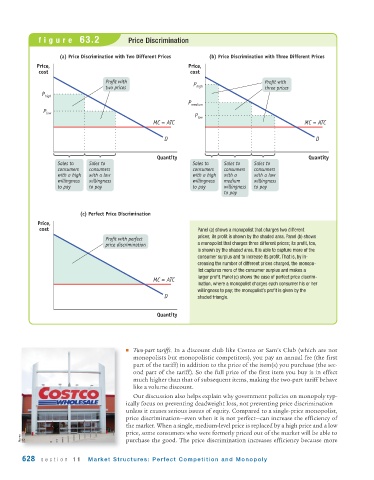Page 670 - Krugmans Economics for AP Text Book_Neat
P. 670
figure 63.2 Price Discrimination
(a) Price Discrimination with Two Different Prices (b) Price Discrimination with Three Different Prices
Price, Price,
cost cost
Profit with Profit with
two prices P high three prices
P high
P medium
P low
P low
MC = ATC MC = ATC
D D
Quantity Quantity
Sales to Sales to Sales to Sales to Sales to
consumers consumers consumers consumers consumers
with a high with a low with a high with a with a low
willingness willingness willingness medium willingness
to pay to pay to pay willingness to pay
to pay
(c) Perfect Price Discrimination
Price,
cost Panel (a) shows a monopolist that charges two different
prices; its profit is shown by the shaded area. Panel (b) shows
Profit with perfect
price discrimination a monopolist that charges three different prices; its profit, too,
is shown by the shaded area. It is able to capture more of the
consumer surplus and to increase its profit. That is, by in-
creasing the number of different prices charged, the monopo-
list captures more of the consumer surplus and makes a
larger profit. Panel (c) shows the case of perfect price discrim-
MC = ATC
ination, where a monopolist charges each consumer his or her
willingness to pay; the monopolist’s profit is given by the
D shaded triangle.
Quantity
■ Two-part tariffs. In a discount club like Costco or Sam’s Club (which are not
monopolists but monopolistic competitors), you pay an annual fee (the first
part of the tariff) in addition to the price of the item(s) you purchase (the sec-
ond part of the tariff). So the full price of the first item you buy is in effect
much higher than that of subsequent items, making the two-part tariff behave
like a volume discount.
Our discussion also helps explain why government policies on monopoly typ-
ically focus on preventing deadweight loss, not preventing price discrimination—
unless it causes serious issues of equity. Compared to a single-price monopolist,
price discrimination—even when it is not perfect—can increase the efficiency of
the market. When a single, medium-level price is replaced by a high price and a low
price, some consumers who were formerly priced out of the market will be able to
Alamy purchase the good. The price discrimination increases efficiency because more
628 section 11 Market Structures: Perfect Competition and Monopoly

